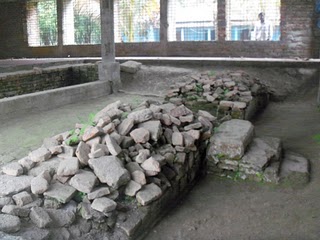 |
| Lost mosque, Lalmonirhat |
In what is now the fourth largest Islamic population in the world, Bangladesh has a history of Islam that goes back, almost certainly, to the lifetime of the Holy Prophet himself.
The Sunni Muslim population is one of the most liberal in the Islamic world, apart, perhaps, from Indonesia, and that continues a history of religious tolerance and coexistence of over two millennia, first when Hindus learnt the trade perils of persecuting the animists and shamanic peoples, then the rising adherence to Buddhism, and later, under first the Mughals, then the British.
Peace, it has been said, is the natural consequence of trade. It might also be said that peace is a prerequisite to trade, and since Bangladesh, from at least the middle of the 1st millennium BCE, was probably a vital link in a worldwide trade route between South and South East Asia, Arabia and Europe, and the Empires of Central and Eastern Asia, the peoples and kings and chiefs along the Brahmaputra River wanted to take no risks with the very remunerative trade that flowed along that river.
 |
| Kusumba Mosque, Naogaon |
It was certainly that trade that brought the earliest converts to the Silk Road from which so many Arabian merchants made their living.
What appears to be the remains of a mosque, the dating plaque of which tells of its construction in 701 CE, just 69 years after the Holy Prophet’s death, has been found at Lalmonirhat in the north of Bangladesh.
It stands at the junction of the Brahmaputra and Teesta rivers, which continued to be a major communications centre, right up to the age of the railway. With a choice of routes into Central Asia, along the Teesta to Sikkim, and over the mountain pass into Tibet, or along Brahmaputra to northern Assam, then by well-trodden road through upper Myanmar into Yunnan Province of China, both the ancient Tibetan Empire, and that of China and Mongols could be reached.
It was in ‘the peace of the Silk Road’ that it appears that Buddhism flourished, and took its beliefs by the Silk Road into Central and Eastern, even South Eastern Asia, and there is no doubt that the same route carried Islam, from earliest times, to China, where it became an important part of the development of science studies, and into Central Asia.
In Bangladesh, the earliest traders, some of whom no doubt settled in the flourishing cities along the Brahmaputra, and where converts were also doubtless made, the stories of the civilisation that certainly flourished along the Road, and such as the 2nd Century map of Ptolemy, the Greek cartographer, and 12th Century Islamic mapping no doubt motivated the Sufi missionaries, from Yemen, Persia, Turkey and across the Islamic world of the Middle Ages to travel and spread the word.
 |
| 60 Dome Mosque, Bagerhat |
In the early 13th Century came the first real invaders, originating in Afghanistan, where they would certainly be aware of fabled wealth of this rival trade route, seized the mouth of Brahmaputra and the lands around it. Others followed. Indeed, in the 15th Century, there was a Sultan originating in Abyssinia. By the middle of the 16th Century, the Mughals arrived, reached a settlement with their Afghan rivals, and the age of Islam had truly arrived in Bangladesh.
There are many fine mosques across the country that bear testimony to the art and skills of the period of Muslim domination, but that rule was not to last.
The wealth of the Silk road attracted Europeans, first the Portuguese, in mid-16th Century, followed by the French, the Dutch and the British, all of whom, however, also understood that, whilst they might scrap amongst themselves, attacking the trade on the Brahmaputra, or those who carried out the trade, was in no one’s interests.
It remained for the 1947 partition of India for Muslim domination of the land to return. But by then, the Empires of the East had disappeared, and there was only local trade left, and following partition, the trade along Brahmaputra even into Assam, even that disappeared.
It may be that, in the coming years, there will be a reversal of fortunes, as India, Nepal and Bhutan seek access to the sea, and the Chinese seek harbour facilities on the Bay of Bengal. But one thing is certain; Islam will continue to be the faith of most Bangladeshis.




















